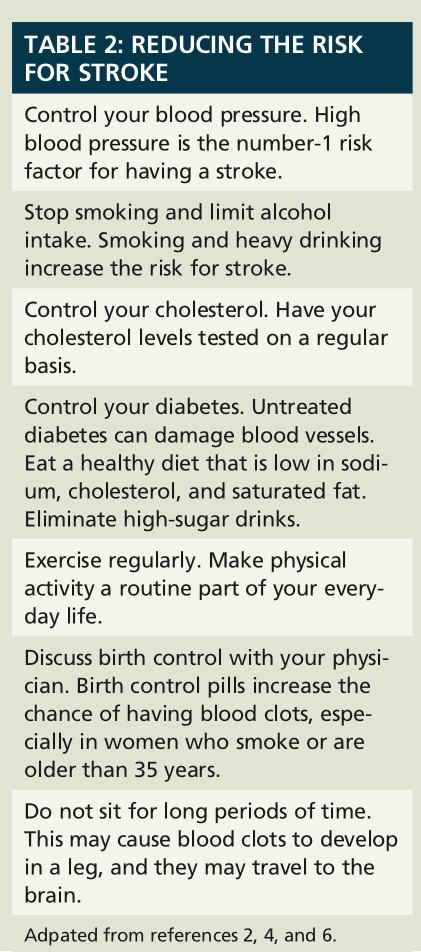Preventing Stroke
Understanding stroke is the first step in knowing how to prevent it.
Understanding stroke is the first step in knowing how to prevent it.
What Is a Stroke?
Each year, 795,000 Americans have a stroke. It is the fourth-leading cause of death in the United States. One American dies of a stroke every 4 minutes. Stroke causes more serious long-term disabilities than any other disease.1,2
A stroke occurs when oxygen-rich blood cannot reach brain cells. Without oxygen, brain cells start to die. One reason oxygen-rich blood cannot reach brain cells is that the arteries to the cells are blocked. Blood clots are the most frequent cause of blocked arteries. In some instances, blood clots form in another part of the body and travel to the brain. Another type of clot is caused by cholesterol deposits that build up in the arteries blocking blood flow. Approximately 85% of strokes are caused by blocked arteries.3
A second type of stroke is caused when bleeding occurs in the brain or on the surface of the brain. Bleeding occurs when an artery bursts due to high blood pressure. In other instances, a weakened artery wall eventually bursts. This type of stroke is sometimes called a brain bleed. The pressure from the leaked blood damages surrounding brain cells. Bleeding also reduces the amount of blood that reaches brain cells. Sometimes, an individual may experience stroke symptoms that last for only a short period of time. This is called a ministroke. Ministrokes leave no permanent damage but increase the risk for more serious strokes. A stroke is a medical emergency requiring immediate treatment (the sidebar lists the symptoms of stroke).

Why Are Some People More Prone to Having a Stroke?
People with heart disease, high blood pressure, diabetes, and high cholesterol are at increased risk for having a stroke. Other risk factors include a family history of stroke, alcohol or drug abuse, stress and depression, and certain medical conditions.2 Race and age are also risk factors. African Americans have the highest risk for stroke. Nearly 75% of all strokes occur in people older than 65 years.1,4
How Is Stroke Treated?
Both types of stroke are treated with a combination of surgery, medication, and rehabilitation. Treatment also consists of life-style changes, including smoking cessation, exercise, a healthy diet, and weight reduction. Online Table 1 summarizes frequently used treatments.
Table 1: Treating Stroke
Strokes caused by blocked arteries
• Medications called clot busters are administered as soon as possible. To be effective, these medicines must be administered within 3 hours after symptoms appear.
• Doctors may remove the clot by inserting a tiny device that physically grabs and removes the clot.
• A flexible catheter is inserted into the groin and threaded to the tiny arteries of the brain. Your doctor can deliver medicine through this catheter to break up a blood clot.
• A blood thinner may be prescribed. This may include aspirin or prescription medications. Medication to reduce cholesterol levels may also be prescribed.
• Rehabilitation is provided.
Strokes caused by bleeding
• Surgery may be required to repair weakened arteries.
• If the bleeding causes pressure around the brain, a small opening is made into the skull to relieve pressure.
• Medications are given to lower high blood pressure.
• Rehabilitation is provided.
Adapted from references 2, 3, and 5.
Stroke results in various disabilities. Recovery may take weeks, months, or even years. Often, stroke affects language, speech, and memory. Muscle and nerve problems, along with bladder and bowel problems, are common effects of stroke. Stroke victims may have problems walking and a loss of balance and coordination. A serious stroke may result in partial paralysis. Additionally, some stroke victims have problems swallowing and eating. Stroke victims may also have difficulty controlling their emotions.
Occupational therapists work with patients to help restore some of these lost functions. Many stroke victims have some type of long-term disability. The disability depends on the brain tissue that is damaged. The good news is that more than 50% of people who have a stroke are able to function and live independently. The others require caregiver assistance.6
Is There Anything I Can Do to Prevent or Minimize the Risk for Having a Stroke?

Stroke prevention focuses on decreasing known risk factors (Table 2). For brain bleeding, treating hypertension is the most effective intervention. Increased physical activity decreases the risk of stroke by 25% to 30%.5
Where Can I Find Additional Information?
The American Stroke Association (www.strokeassociation.org) has easy-to-understand information and also coordinates support groups, which can help you understand how others have coped with having a stroke.
References
- National Institutes of Health, Senior Health. About stroke. http://nihseniorhealth.gov/stroke/aboutstroke/01.html. Accessed October 4, 2013.
- National Heart, Lung, and Blood Institute. What is a stroke? www.nhlbi.nih.gov/health/health-topics/topics/stroke. Accessed October 4, 2013.
- Mayo clinic staff. Stroke. www.mayoclinic.com/health/stroke/DS00150. Accessed October 4, 2013.
- National Institute on Aging. Stroke. www.nia.nih.gov/health/publication/stroke. Accessed October 4, 2013.
- Silver B. Stroke prevention. http://emedicine.medscape.com/article/323662-overview. Accessed October 4, 2013.
- MedlinePlus. Stroke. National Library of Medicine. www.nlm.nih.gov/medlineplus/ency/article/000726.htm. Accessed October 4, 2013.
